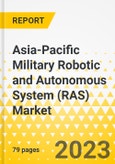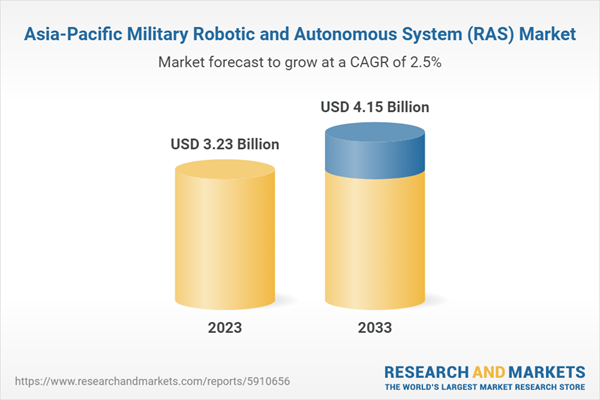This report comes with 10% free customization, enabling you to add data that meets your specific business needs.
Market Introduction
The military robotic and autonomous system (RAS) market in Asia-Pacific (APAC) is expanding at a rapid pace due to the region's growing emphasis on bolstering defense capabilities by using cutting-edge technologies. The requirement for enhanced operational efficiency, reconnaissance, and surveillance in complex and dynamic security situations is what is driving the market for Military RAS in the Asia-Pacific region. APAC countries are investing more in unmanned technologies, such as aerial drones, ground robots, and autonomous vehicles, as geopolitical tensions continue and military modernization efforts pick up speed. These systems are essential for improving overall operational performance, lowering human risk in dangerous situations, supplying real-time intelligence, and strengthening military capabilities. Continuous technical development and partnerships between defense agencies and business entities are anticipated to further propel the growth of the APAC Military RAS market in the foreseeable future.Market Segmentation:
Segmentation 1: by Application
- Intelligence, Surveillance, and Reconnaissance (ISR)
- Combat Operation
- Target Acquisition
- Logistics
- Mine Clearance, Explosive Ordnance Disposal (EOD), and Chemical, Biological, Radiological, and Nuclear (CBRN)
- Infantry Support
- Others
Segmentation 2: by Platform
- Unmanned Aircraft Systems
- Unmanned Ground and Robotic Systems
- Unmanned Maritime Systems
Segmentation 3: by Country
- China
- India
- Japan
- South Korea
- Rest-of-Asia-Pacific
How can this report add value to an organization?
Product/Innovation Strategy: The product segment aids the reader in understanding the different types of military RAS and their potential in Asia-Pacific region. Additionally, the study provides the reader with a detailed understanding of the different military RAS based on application (intelligence, surveillance, & reconnaissance (ISR), combat operation, target acquisition, logistics, mine clearance, EOD, CBRN, infantry support and others), platform (UAS (MALE UAVs, HALE UAVs, UCAVs, unmanned helicopters, small UAVs, loitering munition UAVs), UGRS (UGVs, robots, humanoid robots), UMS (autonomous maritime surface vehicles, autonomous maritime underground vehicles)), operation mode (UAS (autonomous, semi-autonomous), UGRS (autonomous, semi-autonomous), UMS (autonomous, semi-autonomous)).Growth/Marketing Strategy: The Asia-Pacific military RAS market has witnessed major development by key players operating in the market, such as business expansion, contracts, mergers, partnerships, collaborations, and joint ventures. The favored strategy for the companies has been contracts, enabling them to strengthen their positions in the Asia-Pacific military RAS market.
Competitive Strategy: The key players in the Asia-Pacific military RAS market analyzed and profiled in the study involve military RAS manufacturers. Moreover, a detailed competitive benchmarking of the players operating in the Asia-Pacific military RAS market has been done to help the reader understand how players stack against each other, presenting a clear market landscape. Additionally, comprehensive competitive strategies such as contracts, partnerships, agreements, acquisitions, and collaborations will aid the reader in understanding the untapped revenue pockets in the market.
Key Market Players and Competition Synopsis
The companies that are profiled have been selected based on inputs gathered from primary experts and analysing company coverage, product portfolio, and market penetration.Some of the prominent names established in this market are:
- Defence Research and Development Organisation (DRDO)
- Hanwha Defense
This product will be delivered within 3-5 business days.
Table of Contents
Executive Summary
The Asia-Pacific military RAS market is estimated to reach $ 4.15 billion by 2033, reveals the premium market intelligence study. The study also highlights that the market is set to witness a CAGR of 2.54% during the forecast period 2023-2033.The Asia-Pacific Military Robotic and Autonomous System (RAS) Market: Drivers and Challenges
Startups across China, India, Japan, South Korea, and Australia are securing funds to design and develop unmanned systems and related software to strengthen their respective armed forces is propelling Asia Pacific military RAS market.The weaponization of Asia Pacific military RAS is currently not permitted, which further creates a challenge for its adoption among countries.
USPs of report
Market ranking analysis based on product portfolios and recent developments
- Analysis of business drivers and challenges of the Asia-Pacific Military Robotic and Autonomous System (RAS) Market
- Detailed analysis of Military Robotic and Autonomous System (RAS) Market for China, Japan, India, and South Korea
- A detailed company profile comprising established players
Analyst’s Perspective on Asia-Pacific Military Robotic and Autonomous System (RAS) Market
The Principal Analyst states, 'Evolving human safety requirements in the military domain is driving the uptake of robotics. Remotely piloted aircraft systems will continue to dominate this segment, while the firefighting and explosive handling use cases will continue to observe a rise in the deployment of robotic systems. While the current trend of robotics deployment as a means of enhanced safety and convenience for military users will continue, the overall uptake is expected to grow across the services. Naval modernization will drive the uptake of unmanned surface and sub-surface vessels across multiple applications collaborating with manned platforms. The evolution of AI capabilities will further drive the uptake of robotics in the military domain as their effectiveness is expected to improve as a consequence.'Some of the prominent names established in this market are:
- Defence Research and Development Organisation (DRDO)
- Hanwha Defense
Key Questions Answered in the Report
- What are the futuristic trends in Asia-Pacific military RAS market, and how is the market expected to change over the forecast years 2023-2033?
- What are the key drivers and challenges faced by the companies that are currently working in the military RAS market?
- How is the market expected to grow during the forecast period 2023-2033?
- What are the opportunities for the companies to expand their businesses in the military RAS market?
- Which platform is estimated to be leading the military RAS market by 2033?
- What are the key developmental strategies implemented by the key players to sustain in this highly competitive market?
Companies Mentioned
- Defence Research and Development Organisation (DRDO)
- Hanwha Defense
Table Information
| Report Attribute | Details |
|---|---|
| No. of Pages | 79 |
| Published | November 2023 |
| Forecast Period | 2023 - 2033 |
| Estimated Market Value ( USD | $ 3.23 Billion |
| Forecasted Market Value ( USD | $ 4.15 Billion |
| Compound Annual Growth Rate | 2.5% |
| Regions Covered | Asia Pacific |
| No. of Companies Mentioned | 2 |









